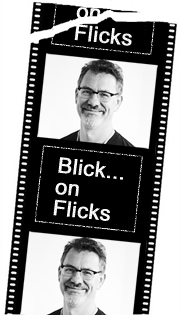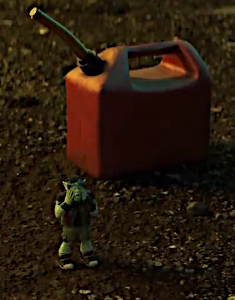Blick on Flicks
Onward: Pixar's Tribute to Dungeons and Dragons
By Jacob Clark Blickenstaff

It has been a while since audiences have seen a new Pixar film that was not part of a series or a sequel. Onward (2020), which is available to watch online now, introduces viewers to a world where magic is present, but old fashioned. No humans exist in the Onward universe; it is populated with pixies, elves, dragons, centaurs, and unicorns instead. In the distant past, magic held sway, but once electricity was discovered and made to light a light bulb, folks began to switch to technological solutions.
Onward's collection of creatures and their abilities reminded me of playing Dungeons and Dragons, which was no accident: A prominent thanks to the publishers of D&D appears in the credits.
The story centers on two young elves, Ian Lightfoot (voiced by Tom Holland) and his older brother Barley (voiced by Chris Pratt). Their father, Wilden, died before Ian was born and when Barley was just a few years old, so they have been raised by their mother, Laurel (who is voiced by Julia Louis-Dreyfus). When Ian comes of age at 16, he inherits a staff, a jewel, and a spell left behind by his father. The spell will allow Wilden Lightfoot to return from the dead for just one day, and casting the spell will consume the jewel.
Of course Ian and Barley try out the spell, but something goes wrong, and only half of their father is restored when the jewel is consumed. Unfortunately, it is the bottom half, basically from his feet to his belt. To bring the rest of their father back, they will need another magical "phoenix stone," and they will have to get it in 24 hours. What follows is their quest to find the phoenix stone and recast the spell before time runs out. Along the way, they meet pixies on motorcycles and a manticore tavern owner, and ride on an unconventional boat down a subterranean river.
Through all the adventure in a movie based in magic, it might seem a stretch to find science connections, but I did spot some fun physical science connections that middle and high school teachers could use.

In one scene in Onward's trailer, Ian attempts a spell to make a gas can larger (thereby creating more gas for Barley's van). The spell goes wrong, and Ian shrinks Barley to just a few inches tall. Barley's voice becomes very high-pitched and squeaky when this happens, and that is exactly what physics says should happen.
We make sound with our voices by pushing air through the voice box, or larynx. The larynx includes the vocal cords and the cartilage that moves the vocal cords as we breath and speak. The vibrations of the vocal cords are amplified by the shape of the throat and nasal passages. When Barley becomes tiny, his larynx and nasal passages get smaller, which causes his voice to get higher. The smaller space amplifies shorter wavelengths of sound (which are the higher-pitched sounds).
Some students might think that this is what happens when someone inhales helium, but it isn't. Helium in the larynx changes which frequencies are amplified because sound travels faster in helium than in air. Breathing a gas that has a lower speed of sound would lower the voice. (Please note: It is not a good idea for an adult to inhale helium, and never allow students to breathe helium in class.)
A key plot point near the film's end involves sunset. (I won't reveal the details here, for those who have not yet seen Onward.) The scene got me thinking about how long it actually takes for the sun to set; that is, how long it is from the moment the disc of the sun appears to touch the horizon until the sun sets fully below the horizon. In the movie, the full sunset takes about five minutes, but doesn't seem to flow at a constant rate. The actual time varies quite widely with the season and with latitude.
Here is one way to think about it: Recall that the reason the sun appears to set is that the Earth is rotating on its axis, which it does once every 24 hours. A point on the equator travels about 40,000 km in 24 hours, so it is moving at almost 1,700 km/hr. Points north and south of the equator travel in smaller circles, so they are not moving as fast.
As an example, Seattle is about 48 degrees north of the equator, so the circle my house makes each day is only 27,000 km in circumference, which means I'm moving at only about 1,100 km/hr. Since Seattle is not moving as fast as places near the equator, sunsets take longer here than in Bogota, which is just 4 degrees north. Typical sunset time on the equator is just more than 2 minutes, which does not change much through the year. Far from the equator, seasonal variation is large: from 3.5 to 4.5 minutes at 50 degrees north or south.
Of course, within the Arctic circle, there is a period of time with no sunset in the summer, and no sunrise in the winter. If you or your students care to look very closely at the end of the movie, you will be able to find an inconsistency in how the sunset proceeds, which could mean that magic is not only able to temporarily bring someone back from death, but also alter how quickly or slowly time passes.
While Onward is not likely to join classics like Toy Story and The Incredibles as a Pixar masterpiece, it has some fun moments teachers can use to discuss the physics of sound and planetary geometry.
Note: Onward is rated PG for action/peril and some mild thematic elements.
Jacob Clark Blickenstaff is a learning designer with AVID based in Seattle, Washington. He can be reached at jclarkblickenstaff@outlook.com.


